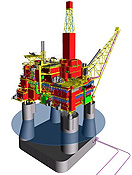News
Tsunami will change how and where
future nuclear power plants are built
-
 Print
Print -
 Comments
(1)
Comments
(1)
-

The offshore platforms sit on four friction pendulum bearings that allow structures to swing gently from side to side, during a earthquake, minimizing the risk of damage to the structure. Graphic: COURTESY OF MCEER
-
Related story
The design of next-generation nuclear power plants and other critical energy facilities will undoubtedly be influenced by the Japanese tsunami and its devastating effects on Japan’s nuclear reactors, a UB structural engineer says.
“If a nuclear reactor is built at a site where a 30-foot tsunami wave is possible, if it comes, it is going to have a significant effect; there is no way to control for that,” says Michael C. Constantinou, professor of civil, structural and environmental engineering and researcher with UB’s MCEER (Multidisciplinary Center for Earthquake Engineering Research). He works on seismic protective systems that deflect and dissipate seismic energy and protect structures during earthquakes.
“The only way to prevent the situation is to build the plant further inland, to seismically isolate it and, perhaps, to elevate it,” he says.
Constantinou notes that it is possible to seismically isolate an entire facility on a concrete platform.
“This is possible technologically, but much more complex,” he says.
Constantinou is familiar with this technique, having consulted with UB colleague Andrew Whittaker on the design of seismically isolated offshore oil-and-gas drilling platforms in the North Pacific near Russia’s Sakhalin islands, several hundred miles north of the epicenter of the March 11 Japanese earthquake.
“These platforms sit on concrete bases on the ocean floor with legs that are about 80 meters tall, and the structure on top of the platform is another 20 stories high; the entire structure weighs some 30,000 tons,” he explains.
“Conditions there are extreme,” he continues. “It is a multi-hazard environment, where one hazard can worsen the effects of another. The platforms are designed to withstand, without failure or significant effect, major earthquakes, ice forces on platform legs where giant slabs of ice 2 meters thick can form, temperatures as low as -40, blasts and very large waves on the order of 10 meters above the ocean’s surface, which only may occur once every 10,000 years, and waves in combination with ice slabs,” he says. “They are very difficult structures to design.”
The offshore platforms, about 100 meters by 100 meters in plan dimensions, sit on four friction pendulum bearings, each of which has the capacity to safely carry 13,000 tons. The friction pendulum bearings allow structures to respond to strong earthquakes by swinging gently from side to side, like a pendulum, minimizing the risk of damage to the structure and the people who work inside it.
Constantinou says the bearings, made of steel ductile to very low temperatures and that have a large displacement capacity and a capacity to carry such large loads, are the only ones suitable for the extreme conditions encountered in the North Pacific.
“It wouldn’t be possible to use elastomeric—rubber—bearings, which are very frequently used in Japanese buildings,” Constantinou explains. “At those very low temperatures, the rubber bearings become brittle and can shatter like glass. Also, these loads and displacement demands are too large for elastomeric bearings.”
UB faculty often travel to countries and regions devastated by earthquakes, as part of international efforts to improve seismic design of buildings and infrastructure. Disaster mitigation, response to extreme events and multi-hazard engineering are research strengths of the university identified in the UB 2020 strategic plan.

Reader Comments
Bill Wachob says:
Or another option would be not to build more nuclear power plants. Why risk it? We always hear, first that chances of catastrophies are infitesimal, then after it happens that we can learn from this and design it so that next time it won't happen. I'd say the wisest decision is that we don't NEED nuclear energy, considering a) we still don't have a good handle on what to do with nuclear waste; b) the downside of nuclear plant breakdowns is huge, look at Japan, or even at a U.S. Nuclear Regulatory Commission report called "Calculation of Reactor Accident Consequences 2" back in 1982 (see http://crocodoc.com/yoz20b , and http://www.democracynow.org/2011/3/17/serious_danger_of_a_full_core); and c) we can develop safe energy generating technologies (currently wind, solar, and hydro).
Posted by Bill Wachob, Senior Assistant Dean, School of Nursing, 03/18/11